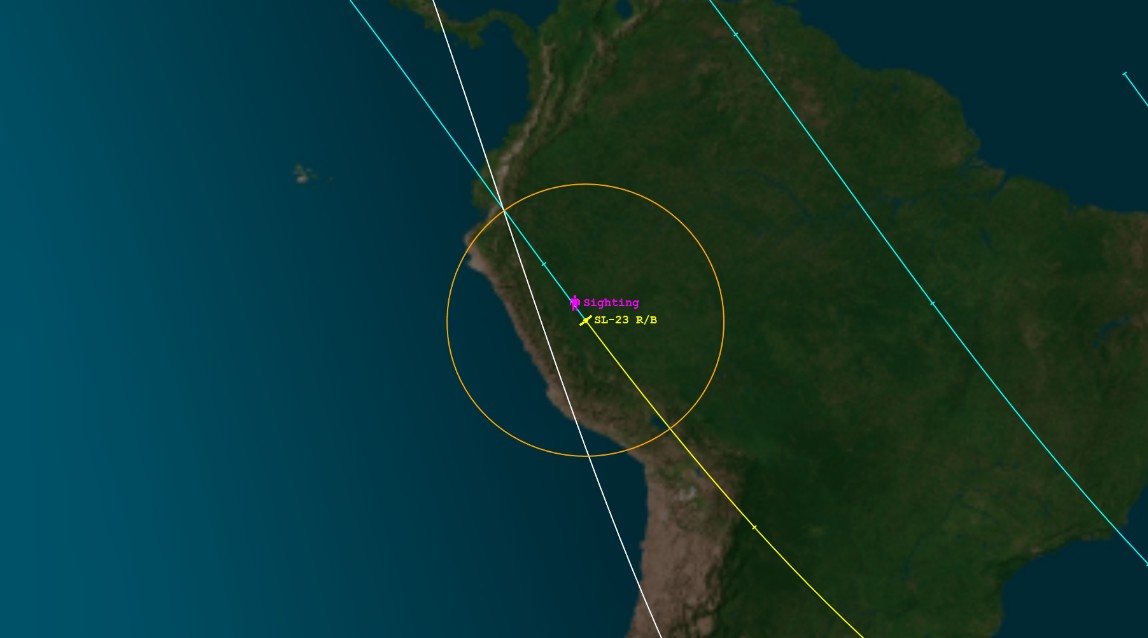Impressive rocket re-entry over South America, large fragment found in Peru

Residents of eastern Brazil and northern Peru witnessed a rare atmospheric re-entry of a recently launched rocket that ended up hard landing in pieces over South America. The rocket was launched from Baikonur Cosmodrome in Kazakhstan on December 26, 2017, carrying AngoSat 1 Communications Satellite.
The SL-23 rocked body (international designation 2017-086D) re-entered Earth's atmosphere at 23:32 UTC on January 27, 2018, providing a rare opportunity to witness a rocket body slowly burning out in the atmosphere.
However, in an even more rare turn of events, a 40 kg (88 lbs) piece of the rocket measuring 1.05 x 2.7 m (41.3 x 106.3 inches) ended its flight hard landing in northern Peru, leaving a 30 cm (11.8 inches) deep and 29 cm (11.4 inches) wide crater.

SL-23 R/B re-entered Earth's atmosphere at 23:32 UTC on January 27, 2018. Credit: Aerospace
As reported by Exoss, witnesses took to social media and shared their images and videos of the re-entry. At the time, it was an unidentified burning object in the sky.
Exoss team later surveyed information about the event and found the following piece of the rocket in Puno region of northern Peru.
Exoss asks everyone who witnessed the phenomenon to report it using the form found at exoss.imo.net. You can send images and videos using the provided form or directly to their WHATSAPP at (12) 98181-7597.
Featured image: SL-23 rocket body fragment found in northern Peru on January 28, 2018. Credit: Exoss.org

Thanks for sharing this! All the best!
Prent – not necessarily. And I’m not saying that it definitely is the object, either. But an object that size by the time it hits the thicker, denser part of the atmosphere is going to decelerate to a much lower velocity and have cooling effects from the air. By the time it hits the ground, it may not even be warm – let alone scorching.
Rocket launches and the subsequent re-entry of parts/probes/capsules etc vary between 7 km/s – 12 km/s. On the other hand, Meteors from space have velocities of 50 km/s or higher. Meteorite fragments big enough to survive the atmosphere are usually free-falling for the last couple of minutes and ‘drop’ on to the ground unspectacularly. Only much bigger objects cause drama – the Russian meteorite a few years back was calculated to have been the size of a bus – most of it exploded at very high altitude. The blasts caused the damage – it could have been far, far worse.
The material a meteorite consists of makes a huge difference too – stony, iron, ice etc. Tunguska explosion was thought to have been an icy comet – hydrogen explosion at altitude, no crater but MASSIVE damage. Over a city, the effects would have been devastating.
So, 1 meter sphere/tank from rocket surviving re-entry? Not surprising really – no crater or firey hole required. It could well be. Occam’s Razor would suggest this to be the most probable explanation.
Excellent explanation!
No way that sphere was the falling object. It would have been far deeper into the soil, as in would’ve made-a-very-large-crater, and the ground would have been scorched from the heat of re-entry. Think, people…